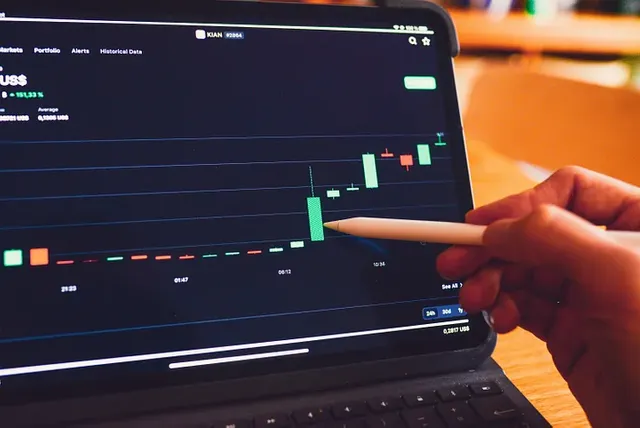
TL;DR:
This article delves into the essentials of swing trading, offering insights into its key strategies for profitability.
It covers the fundamentals, including identifying market trends, using technical indicators, and the importance of risk management.
Insights and tips from successful swing traders and common mistakes to avoid are highlighted.
The article emphasizes continuous learning and improvement, recommending the “Trading for Beginners” course from My Trading Skills, available for free with the coupon "trading100."
Concludes with encouragement for ongoing education and adaptation for swing trading success.
Swing trading is a style of trading that attempts to capture gains in a stock or financial instrument within a short to medium time frame, typically ranging from a few days to several weeks.
This approach is distinct from day trading, where positions are held and liquidated within the same trading day, and from long-term investment strategies that hold positions for months or years.
Swing traders utilize various strategies to take advantage of price “swings” in the market, often relying heavily on technical analysis to identify potential entry and exit points.
Benefits of Swing Trading Over Other Trading Styles
One of the primary benefits of swing trading is its balanced nature. It offers a middle ground between the fast-paced environment of day trading and the long-wait strategies of position trading.
This balance allows traders to potentially reap the benefits of market movements without the stress and time commitment required for day trading or the long holding periods associated with traditional investing.
Swing trading also allows traders to capitalize on shorter-term market trends without the need to constantly monitor the markets throughout the day.
This makes it an ideal strategy for those who cannot dedicate their entire day to trading but still wish to actively participate in the market.
Another advantage of swing trading is its flexibility. Swing traders can adapt quickly to changing market conditions, which can be particularly beneficial in volatile markets.
This flexibility, combined with a lower time requirement, makes swing trading an attractive option for many traders.
Potential for Profit in Swing Trading
Swing trading offers significant profit potential, especially for those who are adept at analyzing market trends and timing their trades effectively.
By capturing substantial price movements over short to medium periods, swing traders can accumulate profits that may rival or even surpass those from longer-term investments, albeit typically with higher risk.
The ability to use various financial instruments, such as stocks, options, and ETFs, allows swing traders to diversify their strategies and increase profit opportunities.
Furthermore, by employing effective risk management techniques and maintaining discipline in their trading approach, swing traders can minimize losses and enhance their overall profit potential.
Swing trading presents a dynamic and potentially lucrative trading style, offering a unique blend of speed, flexibility, and profit opportunity.
It appeals to those seeking more active involvement in the markets without the intense demands of day trading, and to those looking for more frequent returns than traditional long-term investing typically provides.

Understanding the Basics of Swing Trading
Core Principles of Swing Trading
Swing trading is anchored in a set of core principles that differentiate it from other trading styles and guide traders towards successful practices.
Strategic Entry and Exit Points: The essence of swing trading lies in identifying optimal entry and exit points. This involves recognizing when a trend is starting or ending and capitalizing on these movements for profit.
Risk-Reward Ratio: Essential to swing trading is the understanding and management of the risk-reward ratio. Traders must assess potential gains against possible losses and decide on trades that offer a favourable balance.
Market Analysis: A thorough analysis of market conditions is crucial. This includes understanding broader market trends, sector performance, and individual stock movements.
Time Frames and Holding Periods in Swing Trading
Swing trading operates within specific time frames, distinguishing it from other trading methods.
Short to Medium Duration: Swing trades typically last from a few days to several weeks. This period is long enough to capture significant market movements but short enough to avoid the risks of long-term holds.
Adaptability to Market Conditions: Swing traders must be adaptable, adjusting their holding periods based on market volatility and trend strength. This flexibility is key to maximizing profits and minimizing losses.
The Importance of Technical Analysis in Identifying Trade Opportunities
Technical analysis is a cornerstone of swing trading and is used to identify trading opportunities.
Chart Patterns and Technical Indicators: Swing traders rely heavily on chart patterns (like triangles, heads and shoulders, and flags) and technical indicators (such as moving averages, RSI, and MACD) to predict future market movements.
Volume Analysis: Volume plays a significant role in confirming trends. An increase in volume typically accompanies a genuine trend, while a low volume may indicate a lack of conviction in the price movement.
Trend Analysis: Identifying the direction and strength of market trends is vital. This includes understanding bullish and bearish trends and recognizing signs of trend reversals.
In conclusion, understanding the basics of swing trading involves mastering its core principles, recognizing the appropriate time frames and holding periods, and utilizing technical analysis as a key tool in identifying and capitalizing on market opportunities.
This foundation is critical for anyone aiming to navigate the swing trading landscape successfully.

Developing Swing Trading Strategies
Identifying Profitable Market Trends and Patterns
The first step in developing effective swing trading strategies is identifying profitable market trends and patterns. This requires a keen eye for understanding how markets move and the ability to discern patterns that indicate potential for profit.
Trend Analysis: Recognizing whether the market is in an uptrend, downtrend, or sideways trend is crucial. Each of these trends offers different trading opportunities and risks.
Pattern Recognition: Swing traders often look for specific chart patterns like triangles, channels, head and shoulders, or cup-and-handle formations. These patterns can signal entry and exit points for trades.
Historical Data Analysis: Analyzing past market behaviour can provide insights into future trends. Understanding how certain stocks or sectors have reacted in the past can guide predictions about future movements.
Strategy Building: Entry, Exit, and Risk Management Techniques
Effective strategy building is a critical component of successful swing trading. This involves defining clear entry and exit points, as well as risk management techniques.
Entry Points: Deciding when to enter a trade is pivotal. This decision should be based on a confluence of indicators suggesting an upcoming trend.
Exit Points: Equally important is knowing when to exit, whether to take profits or cut losses. Setting predetermined exit points can help in making emotion-free decisions.
Risk Management: Implementing stop-loss orders and setting maximum loss thresholds per trade are essential practices. This helps in preserving capital and minimising losses during unfavourable market movements.
Balancing Risk and Reward in Swing Trading
The art of swing trading lies in the balance between risk and reward.
Risk-Reward Ratio: Before entering any trade, it’s important to assess the potential reward relative to the risk. A common strategy is to look for opportunities where the potential reward is significantly higher than the risk.
Position Sizing: Deciding how much capital to allocate to a particular trade is crucial. It’s advisable not to risk more than a certain percentage of the total trading capital on a single trade.
Diversification: While not diluting the focus, having a diversified portfolio can help in spreading risk. This involves selecting trades across different sectors or asset classes.
In summary, developing swing trading strategies involves a meticulous process of identifying market trends, building strategies around entry and exit points, and effectively managing risks and rewards. This disciplined approach is key to achieving consistency and success in swing trading.
Technical Tools for Swing Traders
Overview of Essential Technical Indicators
For swing traders, technical indicators are invaluable tools that provide insights into market trends and potential trade opportunities. Key indicators include:
Moving Averages: These indicators smooth out price data to identify the trend direction. The two most common are the simple moving average (SMA) and the exponential moving average (EMA).
Relative Strength Index (RSI): This momentum oscillator measures the speed and change of price movements, helping to identify overbought or oversold conditions.
Moving Average Convergence Divergence (MACD): MACD is used to spot changes in the strength, direction, momentum, and duration of a trend in a stock’s price.
Using Chart Patterns and Candlestick Formations
Chart patterns and candlestick formations are crucial in swing trading as they provide visual cues about market sentiment and potential price movements.
Chart Patterns: Patterns like head and shoulders, flags, and triangles can signal trend reversals or continuations.
Candlestick Formations: Candlestick patterns, such as the doji, engulfing, and hammer, offer insight into market sentiment and can indicate potential reversals or continuations in price.
Implementing Trading Platforms and Tools for Effective Trading
Modern trading platforms offer a suite of tools essential for effective swing trading.
Real-Time Data: Access to real-time market data is crucial for timely decision-making in swing trading.
Charting Tools: Advanced charting tools allow traders to visualize data effectively, making it easier to identify trends and patterns.
Automated Trading Tools: Some platforms offer features like stop-loss orders or alerts that can be set up based on specific criteria, aiding in risk management.

Psychology of Swing Trading
Emotional Discipline and Mindset for Swing Trading
Emotional discipline is a key component of successful swing trading. Maintaining a balanced mindset helps in making rational decisions rather than ones driven by fear or greed.
Handling the Psychological Pressures of Market Fluctuations
Swing trading involves navigating through market ups and downs, which can be psychologically challenging. It’s important to stay focused on the strategy rather than reacting impulsively to short-term market movements.
Stress Management: Developing strategies to manage stress can help maintain clarity and focus.
Avoiding Overtrading: Overtrading can be a result of emotional decision-making. It’s important to recognize this and adhere to a disciplined trading plan.
Importance of Patience in Strategy Execution
Patience is a virtue in swing trading. Rushing into decisions can lead to mistakes, while patiently waiting for the right trade setup can lead to more consistent and profitable outcomes.
Waiting for Trade Setups: Successful swing traders wait for the market to meet their specific criteria before executing a trade.
Long-Term Perspective: Keeping a long-term perspective and not getting discouraged by short-term losses is essential for sustained success in swing trading.
In conclusion, the technical tools and psychological fortitude required in swing trading play a pivotal role in a trader’s success. Mastery of technical analysis tools, combined with emotional discipline and patience, forms the foundation of effective and profitable swing trading strategies.
Learning from Successful Swing Traders
Case Studies of Successful Swing Trading Strategies
Learning from successful swing traders provides invaluable insights into what works in the real world of trading. Studying case studies of successful strategies can highlight the importance of technical analysis, risk management, and market timing.
Real-Life Examples: A detailed analysis of successful swing trades can reveal the thought process and analysis that led to profitable decisions.
Strategy Breakdown: Understanding how these traders identified entry and exit points and how they managed their trades can offer practical lessons for developing your strategies.
Insights and Tips from Experienced Swing Traders
Gleaning wisdom from experienced swing traders can significantly shorten the learning curve for new traders.
Risk Management: Seasoned traders often emphasize the importance of preserving capital and managing risk over chasing profits.
Market Analysis Techniques: Experienced traders can provide insights into effective market analysis techniques and how to interpret various market signals.
Adaptability: Learning how to adapt strategies in response to changing market conditions is a critical skill highlighted by experienced traders.
Common Mistakes to Avoid in Swing Trading
Understanding and avoiding common pitfalls can significantly improve a swing trader’s chances of success.
Overtrading: One of the most common mistakes is overtrading, which can lead to increased costs and reduced focus.
Ignoring Risk Management: Failing to set proper stop-loss limits or risking too much capital on a single trade can lead to significant losses.
Emotional Trading: Allowing emotions to drive trading decisions instead of sticking to a well-thought-out strategy can be detrimental.

Enhance Your Swing Trading Skills with a Free Course
For those looking to deepen their understanding of swing trading, the “Trading for Beginners” course offered by My Trading Skills presents an excellent opportunity. This course covers various aspects of trading, including swing trading strategies, and provides practical, real-world insights.
Comprehensive Learning: The course covers the essentials of swing trading, offering both theoretical knowledge and practical skills.
Free Enrollment: You can enrol in this course for free by using the coupon code "trading100." This is a fantastic opportunity to learn from experts without any financial commitment.
Accessible Online: The course is available online, making it convenient for anyone to start learning at their own pace and from the comfort of their home.
Conclusion
Summarizing Key Strategies for Swing Trading Success
As we wrap up our exploration of swing trading, it’s clear that success in this area hinges on a combination of well-planned strategies, a thorough understanding of market dynamics, and disciplined risk management.
The core components—identifying profitable market trends, employing effective entry and exit strategies, and mastering technical analysis tools—form the backbone of any successful swing trading endeavour.
Additionally, balancing risk and reward while maintaining emotional discipline is crucial for long-term success in the volatile world of trading.
Encouragement for Continuous Learning and Improvement
The journey to becoming a proficient swing trader is ongoing. The markets are dynamic and ever-changing, necessitating a commitment to continuous learning and adaptation.
Engaging with educational resources, such as the “Trading for Beginners” course from My Trading Skills, can provide both newcomers and experienced traders with valuable insights and skills.
Embracing a mindset of continuous improvement and staying updated with the latest market trends and strategies is key to staying ahead of the game.
Final Thoughts on the Journey to Swing Trading Proficiency
Swing trading offers a unique and potentially rewarding path in the financial markets. It strikes a balance between the rapid-fire pace of day trading and the long-term horizon of position trading.
As you embark on or continue your journey in swing trading, remember that success comes from a combination of knowledge, strategy, and psychological fortitude.
With dedication, discipline, and a willingness to learn, the path to swing trading proficiency can be a fulfilling and profitable venture. Whether you are just starting out or looking to refine your skills, remember that each trade is a learning opportunity and a step forward in your trading journey.